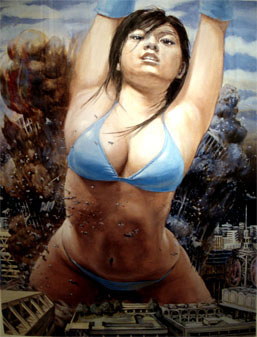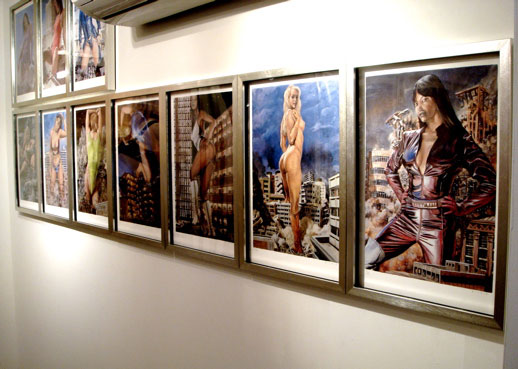Destruction Coupled with Adolescent Provocation
Oozing machismo and a sense of hedonistic havoc, Yasuyuki Nishio’s work, a series of digital enlargements of small oil paintings, depicts giant sensuous women in leather outfits and bathing suits insouciantly demolishing nondescript urban surroundings beneath them. The digital enlargements emphasize the bombastic simplicity of the images: these women strike the poses you would see on the first glossy pages of weekly manga or magazines devoted to hot rods (picture bikini-clad women lounging over metal). These works are essentially a form of manufactured male seduction, albeit with a high degree of technical skill. The women take almost no notice of the destruction they wreak despite the seamless blending of subject and surrounding.

Filling the canvases with their exaggerated poses, and gazing directly at you, the women take on a disproportionate predominance in the image. Underlying this affront, the emotion expressed on their faces is one of contrived allure with a uniform undertone of poised self-objectification. These works seek to juxtapose destruction of the city and seduction of the viewer, but the nonplussed expression on the woman’s faces make any conscious relationship between the two tenuous: Although all around buildings are crumbling and buses are being stomped on, one’s primary concern remains with the model’s fixed stare, rendering the destruction itself incidental. With these emotions seemingly lacking in these subjects, what remains is simply eroticism, comedy and fantasy.
The devastation of a city could evoke a range of emotions, from sympathy for countless victims to pleasure from the power wielded. If there were a more overt emotional relationship between the women and the city we could engage in an element of fantasy similar to that with an action or disaster film where the spectator is allowed a safe distance from destruction able to enjoy violence as well a sense of power without responsibility.
Extensive destruction of a city requires extraordinary power but unlike politics or war the type of power depicted here does not seem to be motivated by aggression, competition or self-preservation. While Makoto Aida’s female figures are the victims of misogynistic abuse, Yasuyuki Nishio’s characters remain unscathed, non-aggressive and seemingly unmotivated in their demolition, although at times they appear satisfied in their exploits. What kind of power proclaims no aggression yet produces large-scale social violence? Perhaps “justice”. Posited as a non-aggressive ideology, “justice” can allow any number of social actions that validate violence, war and revenge, while simultaneously maintaining the status quo by prescriptively defining approved or unacceptable actions, essentially a form of social delineation that prevents the voice of opposition from gaining any strength.

Indeed, there is a heavy dose of sarcasm in the absurdity of these works and in the sex appeal’s blatant delivery, what purpose does this sarcasm serve? If Nishio is suggesting we explore the deeper significance of non-aggressive power in society through his seductive giants, wouldn’t he do better to take his portrayal beyond the constraints of the male adolescent gaze? The lack of complexity in his portrayal of these women might function successfully as a very abstract model of social criticism — namely the message that “power absorbs the spectator’s gaze while violence goes unnoticed” — but the vagueness of the urban environments makes any connection between these women and the city seems tenuous and incidental.
Finally, while the world created within these works is one in which the viewer can engage in a boy’s costumed fantasy, the stage has been reset for the contemporary frustrations and fantasies of an adult male. In a world in which the characters have no real enemy left to fight, destruction is committed, but in the pursuit of no apparent goal outside of destruction itself. One’s environment itself is the threat rather than a battleground for a larger foe. The message of fantasy has becomes simplified adolescent heterosexual lust for sensuous, disposable and inane beauties.
Kenneth Masaki Shima
Kenneth Masaki Shima



